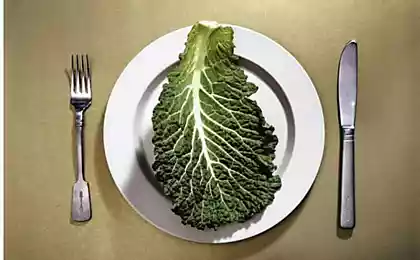166
Why it is useful to get involved in fermented foods
The new is the well-forgotten old. Kimchi, kombucha, miso, sauerkraut and kefir – these fermented foods have been known for centuries, but have recently unexpectedly become a global trend.
1789.
Film stars and modelling are recognized in love with them, restaurant magnates are interested in them, all the leading chefs experiment with them. Ferment, as it turned out, can be almost everything: vegetables, fruits, milk, meat, fish, drinks.
 19
19
And if we do not surprise anyone with soaked apples, sauerkraut and pickles, then easy to digest fermented pumpkin and patissons, onions and garlic, leafy greens, carrots, beets and green beans have not yet become widespread.

Editorial "Site" I decided to fill this gap, and therefore will talk about the fermentation of products at home and share a few simple and useful recipes!
Our ancestors did not know about the beneficial bacteria that live in ready-made home fermentations. For lack of refrigerators, fermentation They were used primarily to preserve products between harvests.

Cabbage was fermented, cucumbers and tomatoes were salted, apples were wet. Although these types of fermentation are called differently, there is no fundamental difference between them.

Roughly speaking, fermentation is the fermentation, or breakdown of organic substances with a lack of oxygen. Starch and sugar from vegetables and fruits, various types of bacteria are converted into lactic acid, which protects food from spoilage and is very useful for the work of the gastrointestinal tract.
Fermented food improves digestion and supports immunity by releasing nutrients from foods and making them more accessible to the body.

So, sauerkraut contains 20 times more easily digestible vitamin C than fresh. Even a small portion of it enriches the body with B vitamins, omega-3 fatty acids, digestive enzymes.
Fermented foods contain probiotics - bacteria useful for the intestinal microflora, which not only fill the lack of useful bacterial flora in the body, but also have a complex healing effect.

Incredibly, 80% of immunity we owe to the intestines. Probiotics directly affect the state of the mucous membranes of the intestine, the production of antibodies to bad bacteria and microbes, including to the causing stomach ulcer Helicobacter pylori.
Thus, fermented foods for the intestines are the main catalyst for powerful protection against most diseases. They protect us from carcinogens, allergens, toxins, improve metabolic processes. And products with them, unlike most superfoods, are cheap and absolutely affordable.
Here you need to pay attention to a number of points. Lactic acid during fermentation appears due to the breakdown of sugars. Therefore, the more sugar in your vegetables, the better and faster the fermentation process will go.
For example, in young cabbage there is less sugar than in late-ripe varieties, so choose for fermentation late. And with cucumbers on the contrary: young contain more sugar, which is why it is better to take them for fermentation.
Fermented green beans
From the ingredients specified in the recipe, approximately two liters of the finished product come out.
The ingredients
Preparation
Basic recipe for fermented vegetables
The ingredients
Preparation
Sauerk beets
From the ingredients specified in the recipe, approximately a liter of a can of the finished product comes out.
The ingredients
Preparation
Sauerk
Pumpkin fermented according to this recipe is both a probiotic and a prebiotic. It colonizes the intestines with beneficial microorganisms and immediately creates an optimal nutrient medium for them (there is a lot of fiber in the pumpkin).
The rate of fermentation of pumpkin depends largely on its original sweetness. Therefore, it is recommended to choose ripe and sweet fruits.
The ingredients
Preparation
Ready-made fermentation is good both in itself and as constituent ingredients in the recipes of other dishes (salads, vinaigrettes, yew, borschea, soups).
This food allows you to improve the digestion process and balance the production of gastric juice. Editorial "Site" It will tell you why it is so important to include enzyme-rich foods in the diet. Prepare and delight your loved ones with delicious and healthy dishes.
Be sure to try making this incredibly tasty sauerkraut with beets. After all, this is a vitamin bomb with Armenian flavor!
What awaits those who constantly eat sauerkraut? You will be surprised, but it is sour cabbage that relieves hangover syndrome, strengthens the body with colds, diseases of the digestive tract, reduces the risk of cancer, relieves toxicosis during pregnancy.
1789.
Film stars and modelling are recognized in love with them, restaurant magnates are interested in them, all the leading chefs experiment with them. Ferment, as it turned out, can be almost everything: vegetables, fruits, milk, meat, fish, drinks.
 19
19And if we do not surprise anyone with soaked apples, sauerkraut and pickles, then easy to digest fermented pumpkin and patissons, onions and garlic, leafy greens, carrots, beets and green beans have not yet become widespread.

Editorial "Site" I decided to fill this gap, and therefore will talk about the fermentation of products at home and share a few simple and useful recipes!
Our ancestors did not know about the beneficial bacteria that live in ready-made home fermentations. For lack of refrigerators, fermentation They were used primarily to preserve products between harvests.

Cabbage was fermented, cucumbers and tomatoes were salted, apples were wet. Although these types of fermentation are called differently, there is no fundamental difference between them.

Roughly speaking, fermentation is the fermentation, or breakdown of organic substances with a lack of oxygen. Starch and sugar from vegetables and fruits, various types of bacteria are converted into lactic acid, which protects food from spoilage and is very useful for the work of the gastrointestinal tract.
Fermented food improves digestion and supports immunity by releasing nutrients from foods and making them more accessible to the body.

So, sauerkraut contains 20 times more easily digestible vitamin C than fresh. Even a small portion of it enriches the body with B vitamins, omega-3 fatty acids, digestive enzymes.
Fermented foods contain probiotics - bacteria useful for the intestinal microflora, which not only fill the lack of useful bacterial flora in the body, but also have a complex healing effect.

Incredibly, 80% of immunity we owe to the intestines. Probiotics directly affect the state of the mucous membranes of the intestine, the production of antibodies to bad bacteria and microbes, including to the causing stomach ulcer Helicobacter pylori.
Thus, fermented foods for the intestines are the main catalyst for powerful protection against most diseases. They protect us from carcinogens, allergens, toxins, improve metabolic processes. And products with them, unlike most superfoods, are cheap and absolutely affordable.
Here you need to pay attention to a number of points. Lactic acid during fermentation appears due to the breakdown of sugars. Therefore, the more sugar in your vegetables, the better and faster the fermentation process will go.
For example, in young cabbage there is less sugar than in late-ripe varieties, so choose for fermentation late. And with cucumbers on the contrary: young contain more sugar, which is why it is better to take them for fermentation.
Fermented green beans

From the ingredients specified in the recipe, approximately two liters of the finished product come out.
The ingredients
- 4-6 tbsp large salt
- 500g young beans
- 2 tbsp searing pepper
- 4 cloves of garlic
- 1 tsp pepper with peas
- 2 dill umbrella
- 2 l of water
Preparation
- Solve the salt in the water.
- Put the pepper, garlic and dill in clean cans.
- Place the asparagus beans on top. Pour brine about 2-3 cm below the edge of the jar.
- Cover the cans on top with cloth. Leave to stew until you get the desired taste.
- After a few days after the fermentation, close the jars with lids and put them in the refrigerator.
- Bon appetit!
Basic recipe for fermented vegetables

The ingredients
- 2-3 tables of sliced vegetables
- 2 tbsp large stone salt
- pepper-pea
- cumin
- garlic
- 1 liter of water
Preparation
- Prepare a brine of boiled water and salt, set it aside for cooling.
- Put the vegetables in a sterilized jar, alternating them with spices.
- Pour brine so that the vegetables are completely covered with liquid.
- Place the load on top.
- Cover with a clean napkin and leave to ferment at room temperature.
- After 3-4 days (depending on the desired taste), close the can with a lid and put it in a cold place. The longer the fermentation process goes, the greater the content of lactobacilli in the product.
- Bon appetit!
Sauerk beets

From the ingredients specified in the recipe, approximately a liter of a can of the finished product comes out.
The ingredients
- 500g beet
- 1.5 tsp cumin seeds
- 1 tsp major salt
- 0.25 tbsp whole leaves of basil
- 2 tables of water
Preparation
- Cut the peeled beets in circles 5 millimeters thick.
- Place on the bottom of a clean jar the seeds of cumin, the leaves of basil, and on top - sliced beet slices.
- Prepare the brine by dissolving the salt in water.
- Pour the beets with brine so that it is all covered with liquid.
- Put a load on it and cover it with a clean cloth.
- Leave the beets fermented at room temperature for 7-14 days.
- As fermentation will increase gas formation.
- When the desired taste is reached, remove the load, cover the jar with a lid and place it in the refrigerator.
- Throw away the basil leaves in a couple of days. Store such beets in the refrigerator can be up to 3 months.
- Bon appetit!
Sauerk

Pumpkin fermented according to this recipe is both a probiotic and a prebiotic. It colonizes the intestines with beneficial microorganisms and immediately creates an optimal nutrient medium for them (there is a lot of fiber in the pumpkin).
The rate of fermentation of pumpkin depends largely on its original sweetness. Therefore, it is recommended to choose ripe and sweet fruits.
The ingredients
- 1kg pumpkin
- 2 tsp salt per 1 litre of water
- dill green
- garlic
Preparation
- Peel the ripe pumpkin and cut into pieces about 0.7 cm thick. The thicker pieces are hard to leave.
- Prepare the brine. To do this, solve salt in 1 liter of drinking water at room temperature. Add the spices.
- Tightly put the pieces of pumpkin in a suitable jar. Add chopped garlic and greens, pour brine so that the jar is filled with liquid to the very top.
- Close the top of the dishes with a cloth so that carbon dioxide freely comes out.
- Leave at room temperature for 4-7 days.
- The indicator of the sourdough process will be carbon dioxide bubbles, a pleasant sour smell and a slight clouding of the brine.
- Periodically make sure that the container is filled with brine to the brim. If necessary, add water.
- For 4 days, try the pumpkin, if it is almost ready, put it in the refrigerator. This will slow down the fermentation and will not allow the product to sour.
- Bon appetit.
Ready-made fermentation is good both in itself and as constituent ingredients in the recipes of other dishes (salads, vinaigrettes, yew, borschea, soups).
This food allows you to improve the digestion process and balance the production of gastric juice. Editorial "Site" It will tell you why it is so important to include enzyme-rich foods in the diet. Prepare and delight your loved ones with delicious and healthy dishes.
Be sure to try making this incredibly tasty sauerkraut with beets. After all, this is a vitamin bomb with Armenian flavor!
What awaits those who constantly eat sauerkraut? You will be surprised, but it is sour cabbage that relieves hangover syndrome, strengthens the body with colds, diseases of the digestive tract, reduces the risk of cancer, relieves toxicosis during pregnancy.
Gold collection of Easter cottage cheese recipes
How to make a spacious and cozy apartment from a small one-piece























